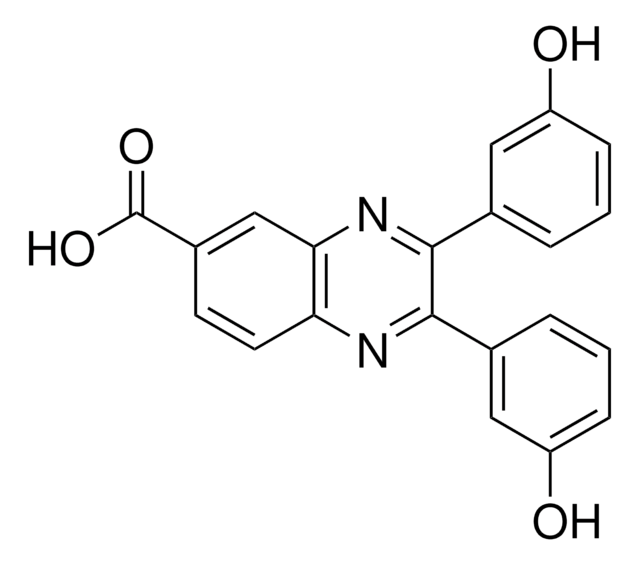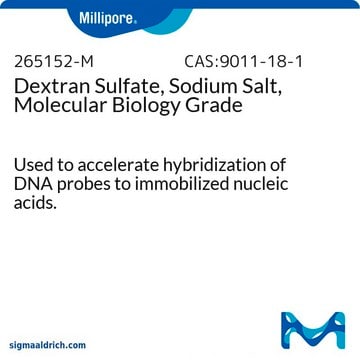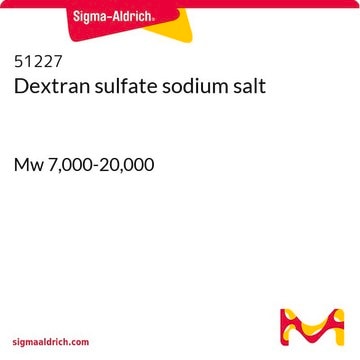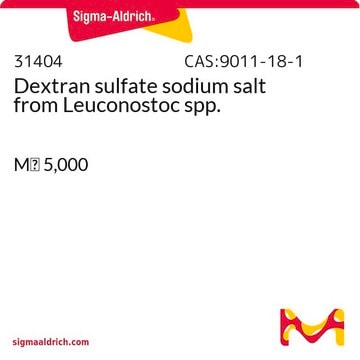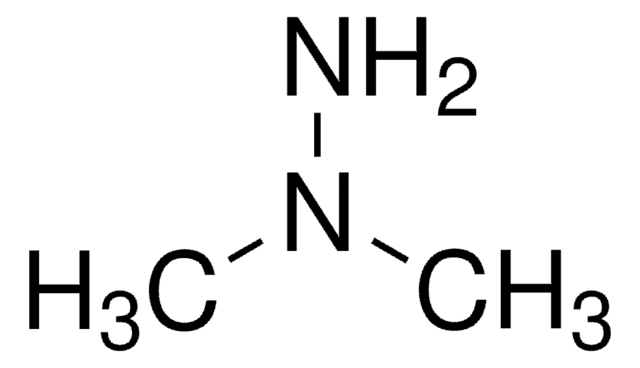If this product has an expiration or retest date, it will be shown on the Certificate of Analysis (COA, CofA). If there is no retest or expiration date listed on the product's COA, we do not have suitable stability data to determine a shelf life. For these products, the only date on the COA will be the release date; a retest, expiration, or use-by-date will not be displayed.
For all products, we recommend handling per defined conditions as printed in our product literature and website product descriptions. We recommend that products should be routinely inspected by customers to ensure they perform as expected.
For products without retest or expiration dates, our standard warranty of 1 year from the date of shipment is applicable.
For more information, please refer to the Product Dating Information document: https://www.sigmaaldrich.com/deepweb/assets/sigmaaldrich/marketing/global/documents/449/386/product-dating-information-mk.pdf
A5486
Azoximetano
13.4 M, ≥98%
Sinónimos:
AOM
About This Item
Productos recomendados
Ensayo
≥98%
Formulario
liquid
composición
methylene chloride, ≤1%
condiciones de almacenamiento
(Keep container tightly closed in a dry and well-ventilated place.)
concentración
13.4 M
color
colorless
bp
97-99 °C (lit.)
densidad
0.991 g/mL at 25 °C (lit.)
aplicaciones
genomic analysis
temp. de almacenamiento
−20°C
cadena SMILES
C\N=[N+](/C)[O-]
InChI
1S/C2H6N2O/c1-3-4(2)5/h1-2H3/b4-3+
Clave InChI
DGAKHGXRMXWHBX-ONEGZZNKSA-N
¿Está buscando productos similares? Visita Guía de comparación de productos
Descripción general
Aplicación
Acciones bioquímicas o fisiológicas
Características y beneficios
Otras notas
Producto relacionado
Palabra de señalización
Danger
Frases de peligro
Consejos de prudencia
Clasificaciones de peligro
Acute Tox. 2 Oral - Carc. 1B - Eye Irrit. 2 - Flam. Liq. 3 - Skin Irrit. 2
Código de clase de almacenamiento
3 - Flammable liquids
Clase de riesgo para el agua (WGK)
WGK 3
Punto de inflamabilidad (°F)
75.2 °F
Punto de inflamabilidad (°C)
24 °C
Elija entre una de las versiones más recientes:
Certificados de análisis (COA)
¿No ve la versión correcta?
Si necesita una versión concreta, puede buscar un certificado específico por el número de lote.
¿Ya tiene este producto?
Encuentre la documentación para los productos que ha comprado recientemente en la Biblioteca de documentos.
Los clientes también vieron
-
How can I determine the shelf life / expiration / retest date of this product?
1 answer-
Helpful?
-
-
How is shipping temperature determined? And how is it related to the product storage temperature?
1 answer-
Products may be shipped at a different temperature than the recommended long-term storage temperature. If the product quality is sensitive to short-term exposure to conditions other than the recommended long-term storage, it will be shipped on wet or dry-ice. If the product quality is NOT affected by short-term exposure to conditions other than the recommended long-term storage, it will be shipped at ambient temperature. As shipping routes are configured for minimum transit times, shipping at ambient temperature helps control shipping costs for our customers. For more information, please refer to the Storage and Transport Conditions document: https://www.sigmaaldrich.com/deepweb/assets/sigmaaldrich/marketing/global/documents/316/622/storage-transport-conditions-mk.pdf
Helpful?
-
-
What is the solubility of product A5486 (Azoxymethane, CAS number 25843-45-2)?
1 answer-
The solubility of Azoxymethane (CAS 25843-45-2) is as follows:
• Water solubility: approximately 100mg/mL
• DMSO solubility: approximately 100mg/mL
• Ethanol (95%) solubility: approximately 100mg/mL
• Acetone solubility: approximately 100mg/mLHelpful?
-
-
Could I know the concentration (mg/ml) and volume of Azoxymethane 13.4M in A5486-100MG?
1 answer-
This product is considered to be a pure/neat chemical (not in solution), with a purity specification of at least 98%. The g/mL would be the density, of 0.991 g/mL. The volume of 100 mg is going to be approximately 100.9 microliters, but products are often over-filled by a few percent, so it would be recommended to still weigh the material during or prior to use.
Helpful?
-
-
Is Axozymethane volatile?
1 answer-
Yes, this compound is considered to be a volatile substance. Please review the entire Safety Data Sheet before handling it.
Helpful?
-
-
How does azoxymethane act to cause cancers?
1 answer-
Azoxymethane is a methylating agent which forms 6-O-methylguanine in DNA. Unless this methylated base is repaired by cellular enzymes, it results in a base mismatch that subsequently causes tumors in the tissue.
Helpful?
-
-
How should stock solutions of Azoxymethane be stored, and for how long can they be kept?
1 answer-
No solution stability studies have been performed by Sigma-Aldrich. Because the solution stability is unknown, solutions should be prepared fresh for use.
Helpful?
-
-
What is the Department of Transportation shipping information for this product?
1 answer-
Transportation information can be found in Section 14 of the product's (M)SDS.To access the shipping information for this material, use the link on the product detail page for the product.
Helpful?
-
-
How does the storage temperature relate to shipping conditions?
1 answer-
The storage conditions that a Sigma-Aldrich catalog and label recommend for products are deliberately conservative. For many products, long-term storage at low temperatures will increase the time during which they are expected to remain in specification and therefore are labeled accordingly. Where short-term storage, shipping time frame, or exposure to conditions other than those recommended for long-term storage will not affect product quality, Sigma-Aldrich will ship at ambient temperature. The products sensitive to short-term exposure to conditions other than their recommended long-term storage are shipped on wet or dry ice. Ambient temperature shipping helps to control shipping costs for our customers. At any time, our customers can request wet- or dry-ice shipment, but the special handling is at customer expense if our product history indicates that the product is stable for regular shipment.
Helpful?
-
-
What solvents can be used to dissolve Azoxymethane?
1 answer-
Azoxymethane is soluble in water, ether, ethanol, and chloroform. The reported solubility in chlorform is 200 mg/mL, and in water is 100 mg/mL.
Helpful?
-
Active Filters
Nuestro equipo de científicos tiene experiencia en todas las áreas de investigación: Ciencias de la vida, Ciencia de los materiales, Síntesis química, Cromatografía, Analítica y muchas otras.
Póngase en contacto con el Servicio técnico
